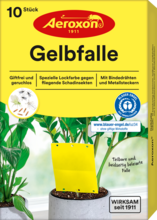
Thrips
Species
e.g. Frankliniella occidentalis, Limothrips cerealium
Size
1.3-2mm in length (Frankliniella occidentalis), wings covered with many bristles
Reproduction
numerous generations per year, partially through asexual reproduction
Diet
Plant juices, but also predatory
Damage
mottled or wilted flower petals, spreading of plant viruses, troublesome if widespread, some species may sting which may cause skin irritation
Solution
adhesive traps, insecticides, biological remedy using lacewings and predatory mites, due to their small size, mosquito nets are not a suitable deterrent
Detailed description
Thrips (thunderbugs, thysanoptera) are an order of insect. They are characterised by their small body size and the adults due to their bristled wings. The body is slim and flat on the back and abdomen. At rest, the wings are folded along the length of the back.
Worldwide, there are approximately 4,500 species, around 500 of which are indigenous to Central Europe.
The most prevalent species in houses, the Western Flower Thrips (Frankliniella occidentalis) is originally from the west coast of North America and has spread all over the world as a result of trade. Eggs are laid near leaf veins. Development involves the completion of two larval stages, first a sap sucking form then in the plant substrate or the soil. During the next two stages of pupation it no longer sucks sap from the plant.
The population growth is largely dependent on the temperature but also on the air humidity and the host plant. A spider mite infestation increases the likelihood of flower thrips. Development is at its fastest at 30°C (approx. 11 days from egg to egg). Reproduction occurs both sexually and asexually. Development ceases to occur above temperatures of 35°C. At lower temperatures, development ceases on open land and the larvae and adults search for sheltered locations to survive the winter, e.g. in greenhouses. In Central Europe, they are not known to survive on open land during winter.
The Western Flower Thrips sucks the juice from the soft tissue cells of leaves, petals and fruit. As a result, spots and dung drops can be found on leaves, with petals showing discolouration. As they continue to grow, these parts of the plant become misshapen and show signs of suberisation. Petals sometimes no longer open at all.
Coloured adhesive panels are suitable for combatting infestations, although these are only effective during the thrips’ flying stages. In professional horticulture, either chemical solutions or beneficial insects, such as predatory mites are used.
Flying thrips can also be caught using small adhesive traps in potted household plants. In this case, it is important to set up the adhesive traps at an early stage before a mass infestation occurs. Temporary cooling of potted plants also reduces infestation.
Recommended Aeroxon products
Yellow Glue Trap for indoor and balcony plants
Non-toxic and ready-to-use glue trap for the control of harmful flying insects on indoor and balcony plants.


